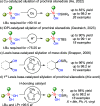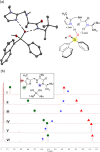Organocatalytic Asymmetric Synthesis of Si-Stereogenic Siloxanols
- PMID: 38269039
- PMCID: PMC10804373
- DOI: 10.1021/acscatal.3c03932
Organocatalytic Asymmetric Synthesis of Si-Stereogenic Siloxanols
Abstract
We report the organocatalytic synthesis of Si-stereogenic compounds via desymmetrization of a prochiral silanediol with a chiral imidazole-containing catalyst. This metal-free silylation method affords high yields with enantioselectivity up to 98:2 for various silanediol and silyl chloride substrate combinations (including secondary alkyl, vinyl, and H groups), accessing products with potential for further elaboration. NMR and X-ray studies reveal insight into the H-bonding interactions between the imidazole organocatalyst and the silanediol and the dual activating role of the Lewis basic imidazole to account for the high enantioselectivity.
© 2024 The Authors. Published by American Chemical Society.
Conflict of interest statement
The authors declare no competing financial interest.
Figures







Similar articles
-
Catalytic Asymmetric Dehydrogenative Si-H/X-H Coupling toward Si-Stereogenic Silanes.Acc Chem Res. 2025 Feb 4;58(3):375-398. doi: 10.1021/acs.accounts.4c00667. Epub 2025 Jan 22. Acc Chem Res. 2025. PMID: 39841996
-
Pseudo-Diastereodivergent Synthesis of Chiral Fluorenes Bearing Bis-1,3-Nonadjacent Stereogenic Centers via Organocatalytic Desymmetrization of meso-Epoxides.Org Lett. 2023 Aug 18;25(32):6006-6011. doi: 10.1021/acs.orglett.3c02150. Epub 2023 Aug 1. Org Lett. 2023. PMID: 37526278
-
Organocatalytic Enantioselective Arylation to Access Densely Aryl-Substituted P-Stereogenic Centers.Org Lett. 2025 Jan 10;27(1):109-114. doi: 10.1021/acs.orglett.4c03992. Epub 2024 Dec 23. Org Lett. 2025. PMID: 39714910
-
Organocatalytic Synthesis of Chiral Halogenated Compounds.Chem Rec. 2023 Jul;23(7):e202300061. doi: 10.1002/tcr.202300061. Epub 2023 Apr 12. Chem Rec. 2023. PMID: 37042453 Review.
-
Organocatalytic enantioselective construction of Si-stereocenters: recent advances and perspectives.Chem Soc Rev. 2024 Aug 27;53(17):8546-8562. doi: 10.1039/d4cs00417e. Chem Soc Rev. 2024. PMID: 39091219 Review.
Cited by
-
Kinetic Resolution of BINAMs by Stereoselective Copper-Catalyzed Dehydrogenative Si-N Coupling with Prochiral Dihydrosilanes.Org Lett. 2025 Jul 11;27(27):7428-7433. doi: 10.1021/acs.orglett.5c02258. Epub 2025 Jul 1. Org Lett. 2025. PMID: 40590348 Free PMC article.
-
Homologous Ladder Cyclohexasilanes.Angew Chem Int Ed Engl. 2025 Jun 28:e202506054. doi: 10.1002/anie.202506054. Online ahead of print. Angew Chem Int Ed Engl. 2025. PMID: 40580501
-
The role of silicon in drug discovery: a review.RSC Med Chem. 2024 Jul 1;15(10):3286-3344. doi: 10.1039/d4md00169a. eCollection 2024 Oct 17. RSC Med Chem. 2024. PMID: 39430101 Free PMC article. Review.
References
-
- Hiyama T.; Oestreich M. Organosilicon Chemistry: Novel Approaches and Reactions. Organosilicon Chem. Nov. Approaches React. 2019, 1–550. 10.1002/9783527814787. - DOI
-
- Rendler S.; Auer G.; Keller M.; Oestreich M. Preparation of a Privileged Silicon-Stereogenic Silane: Classical versus Kinetic Resolution. Adv. Synth. Catal. 2006, 348 (10–11), 1171–1182. 10.1002/adsc.200606071. - DOI
LinkOut - more resources
Full Text Sources
